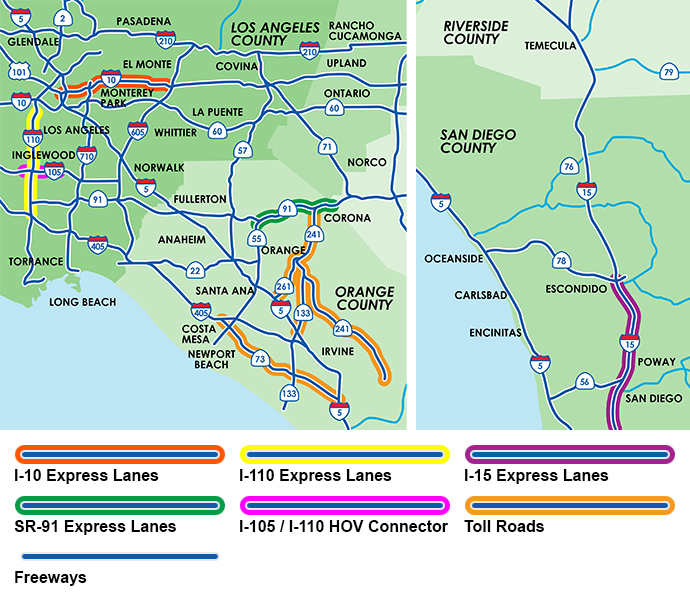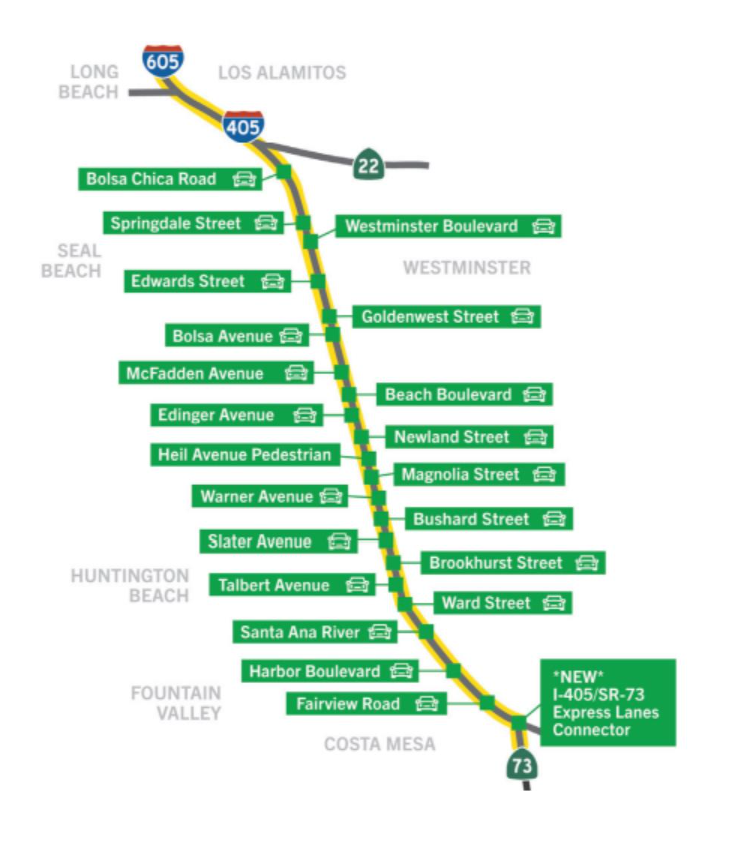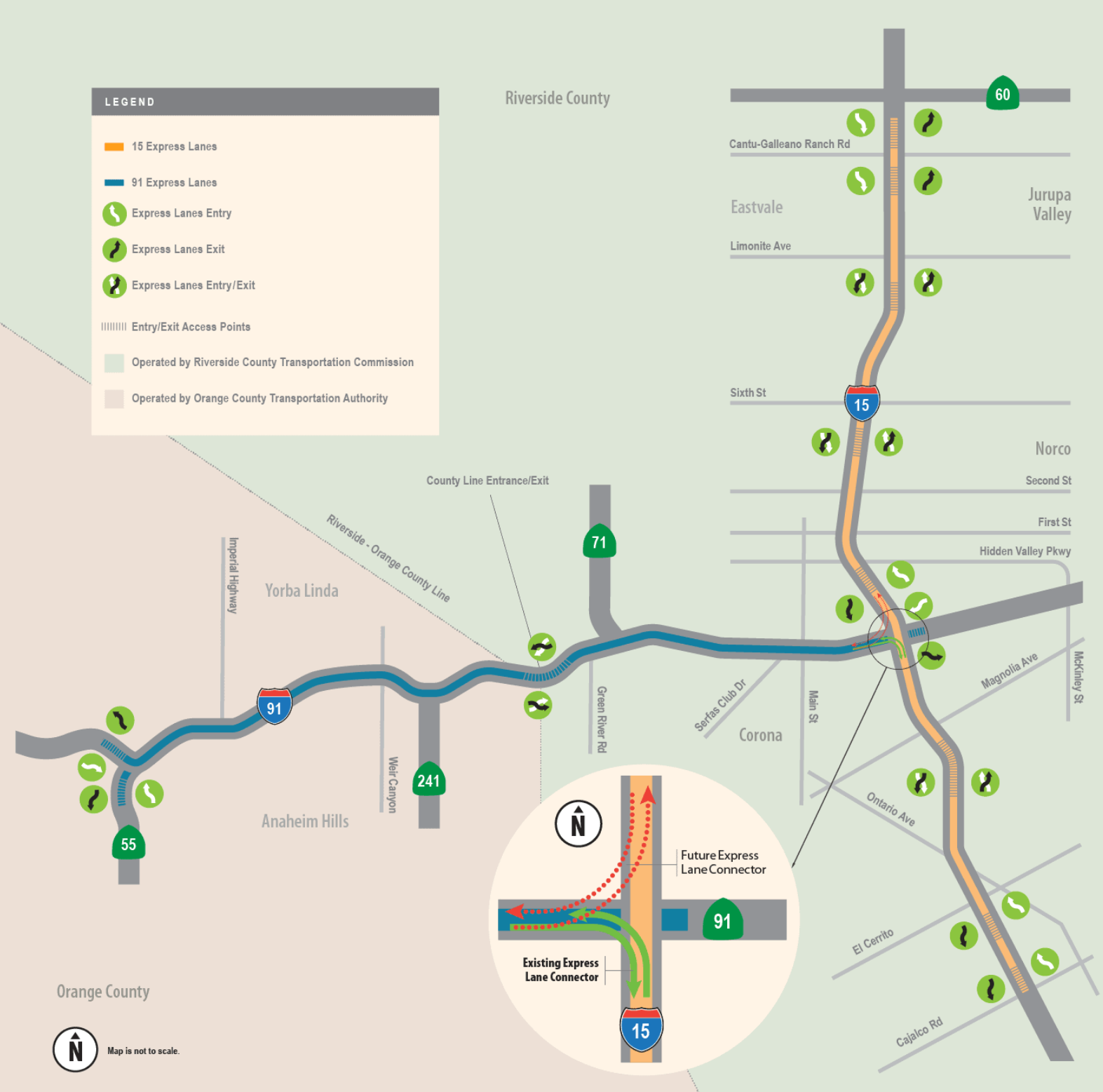
{map}
Toll Roads/Express Lanes in the SoCal 511 region are designed to reduce congestion and offer the option of a faster trip. These Toll Roads/Express Lanes can be found on select freeways in Los Angeles, Orange and Riverside County. FasTrak, an electronic toll-collection system, is used for all the toll roads/express lanes in the SoCal 511 region. Toll rates vary depending on the routes.
Toll roads offer the option of a faster trip, and can be used in LA and Orange counties with a FasTrak® transponder.
FasTrak is an electronic toll-collection system that allows drivers to travel without stopping. Your toll is automatically deducted from a prepaid account using a transponder that is mounted on the inside of your windshield.
FasTrak can be used to pay tolls on all California toll roads, toll lanes and toll bridges. For more information on FasTrak click here. For a map of FasTrak in Southern California click here.
Southern California Toll Road Map

Metro ExpressLanes
Metro ExpressLanes are toll roads in Los Angeles County on the I-10 and I-110 freeways. It is a program designed to improve traffic flow and provide enhanced travel options. ExpressLanes provide mobility and offers safe and reliable trip for users. More choices for solo drivers. More rewards for carpoolers. More transit service.
Tolls on the ExpressLanes will be calculated using Congestion Pricing. Congestion pricing provides an opportunity to sell some of the additional capacity on the ExpressLanes to those willing to pay a toll and maximizes efficiency of the entire freeway. It is designed to keep traffic in the ExpressLanes flowing smoothly, resulting in a more reliable travel time. Tolls on the ExpressLanes are based on real-time traffic conditions and vary according to the level of congestion in the ExpressLanes. The toll is higher when there is more traffic in the ExpressLanes, and lower when traffic is lighter.
FasTrak ® is an electronic toll collection system used on the ExpressLanes as well as other tollways in California that allows drivers to drive through designated "FasTrak® Only" lanes without stopping. There will be no toll booths and all tolls will be collected electronically. All vehicles, except motorcycles, will need a FasTrak® transponder, associated with a valid FasTrak® account, to access the Metro ExpressLanes.
Customers who want the option to travel as a toll-paying solo driver and/or toll free carpooler will need the switchable FasTrak® Flex. Motorists should indicate the number of occupants in their vehicle prior to starting their trip on the ExpressLanes. FasTrak® Flex transponders will be portable and can be moved from one vehicle to another.
Drivers that already have a standard (non-switchable) FasTrak® Flex can only use the Metro ExpressLanes as a toll paying customer. Drivers that want the option to travel toll-free on the Metro ExpressLanes must upgrade to the switchable FasTrak. The Metro ExpressLanes FasTrak® Flex transponder can be used on all other toll facilities in California.
For more information and to open an account, visit metroexpresslanes.net.
Toll Roads in Orange County
Choosing to drive The Toll Roads (State Routes 73, 133, 241 and 261) and the 91 Express Lanes in Southern California can help cut your daily commute time, save stress and get you to your destination faster. Both the 91 Express Lanes and The Toll Roads accept FasTrak for payment. Additionally, The Toll Roads accept other payment methods.
The Toll Roads (State Routes 73, 133, 241, and 261)
Located in Orange County, The Toll Roads are the largest toll road network in California, totaling 51 miles and accounting for more than 20 percent of the highways in Orange County.
Every weekday, more than 250,000 vehicles use The Toll Roads to avoid congested freeways and side streets. They’re the faster, easier way to get where you’re going and can save you time, gas, stress and vehicle wear and tear.
The Toll Roads offer five ways to pay tolls (FasTrak, three new ExpressAccount™ types and a One-Time-Toll™ option), so there's a custom payment method that will work for every driver - no matter their method of payment, when they want to pay their toll and how much of California they intend to explore. Compare all payment methods. Toll rates are available at The Toll Roads’ website.
The Toll Roads have eliminated the need to stop and pay cash at toll booths. Now every vehicle can travel nonstop thanks to four new ways to pay that were developed for drivers by drivers.
The 91 Express Lanes
The 91 Express Lanes is a four-lane, 18-mile toll road built in the median of State Route (SR)-91 between the SR-55/SR-91 interchange and the SR-91/Interstate (I)-15 interchange. Customers may drive the entire length or enter or exit at the county line near Green River Road. The toll for a partial and full trip is posted on the on-road pricing signs and on toll schedules.
The 91 Express Lanes uses congestion management pricing to adjust tolls quarterly based on the number of vehicles. Since 1995, drivers have chosen this proven transportation alternative for safe, reliable, predictable travel to work, home, shopping and whenever they need to be on time.
Motorists pay tolls through the use of a convenient FasTrak® transponder that automatically deducts the toll amount from a prepaid account. You can use a FasTrak® transponder issued by any of the California toll operators or obtain one by opening an account.
Account holders in a vehicle with three or more people may be eligible for free or reduced tolls. Eligible carpoolers (3+) with a transponder-equipped vehicle must drive in the dedicated HOV 3+ lane when approaching the toll gantries in each section of the Express Lanes (Orange County and Riverside County) to receive the discount. Please visit the 91 Express website for current 3+ lane toll policies.
The 405 Express Lanes
The new express lanes – incorporating the existing carpool lanes and connectors that opened in 2014 – will be two lanes in each direction. Visit 405expresslanes.com
The new 405 Express Lanes, new general-purpose lanes, and new local bridges of the I-405 Improvement Project – are expected to improve the drive for everyone at all times of day, whether they choose to use the Express Lanes or regular lanes. Traffic along the corridor is expected to grow by approximately 35 percent by 2040. Improvements are needed to enhance traffic flow, accommodate growing traffic demand, relieve congestion, and improve overall mobility.

91 Express Lanes
RCTC jointly operates the 91 Express Lanes with the Orange County Transportation Authority. In 2017, RCTC extended the 91 Express Lanes into Riverside County. For more information, please visit the 91 Express Lanes website.
Riverside Express
RCTC opened the 15 Express Lanes in April 2021. These lanes operate in the median of Interstate 15 between Route 60 and Cajalco Road. The 15 Express Lanes operate under the RCTC name Riverside Express. For more information about these lanes, please visit the Riverside Express website.
